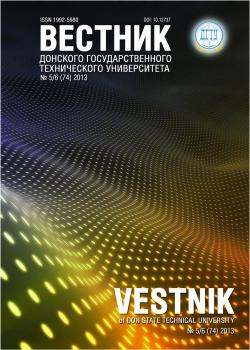A technique for selecting an electrode material used when applying the electrospark method onto a metal surface layer is described. The technique is based on the study of the mechanical properties of the coating by nanoindentation. The coverage microhardness distribution in depth for a number of the investigated materials is developed. As a second characteristic of the material, the plasticity index reflecting the structural state of the material is used during the indentation. Value H/E is also used to describe the capability of materials to frictional wear. A qualitative comparative characteristic — ratio H3/E2 was used to assess the resistance of materials to plastic deformation. Based on the analysis of the obtained results, a reasonable choice of the electrode material which creates coatings with sufficiently high mechanical properties is made. The relevance of the study is proved by the advantages of the electrospark alloying (ESA) which is an effective method of impact on the surface layers of the various parts.
electrospark alloying, mechanical properties, nanoindentation.
Введение. Прогресс в машиностроении, на транспорте и в других областях тесно связан с проблемой повышения износостойкости узлов трения. В решении данной проблемы важную роль играют материалы с покрытиями. Трибологические характеристики узла определяются напряжённо-деформированным состоянием в области контакта, а также в тонких приповерхностных слоях. Нанесение покрытий и модифицирование поверхностного слоя — наиболее рациональный путь, позволяющий направленно изменять напряжённо-деформированное состояние в приповерхностном слое, деформационно-силовые параметры контактных областей и природу контактного взаимодействия тел [1]. Сегодня это общепризнанный факт.
Одним из перспективных методов целенаправленного воздействия на качество поверхностного слоя является способ электроискрового легирования (ЭИЛ). Привлекательность этого метода обусловлена его универсальностью [2–4], т. е. возможностью обрабатывать материалы практически любой формы с любыми физико-механическими свойствами. Необходимо лишь, чтобы они обладали электрической проводимостью. Тепловые процессы локализуются в тонком поверхностном слое. За счёт этого появляется возможность исключить нежелательные структурные превращения в основном металле, что позволяет уже десятки лет успешно использовать данный метод для получения на металлических поверхностях покрытий различного функционального назначения. При электроискровом легировании происходит перенос материала, используемого в качестве анода, на поверхность обрабатываемой детали, которая в электрической схеме метода является катодом. Использование ЭИЛ способствует повышению надёжности и долговечности узлов трения.
1. Kolesnikov, V. I., Ivanochkin, P. G. Dvukhsloinye kompozitcii tribotekhnicheskogo naznacheniia dlia tiazhelonagruzhennykh uzlov treniia. [Double-layer compositions of tribotechnical purpose for heavy-loaded friction units.] Rostov-on-Don : RGUPS, 2009, 124 p. (in Russian).
2. Blazheyev, V. V., et al. Issledovanie vliianiia protcessa elektroiskrovogo legirovaniia na up-rochnenie poverkhnostnogo sloia stali 45. Trudy vserossiiskoi nauchno-prakticheskoi konferentcii «Transport-2012». [Study on the influence of the electric spark deposition process on the hardening of the surface layer of steel 45. Proc. All-Russian Sci.-Pract. Conf. ‘Transport 2012’] Rostov-on-Don, RSTU, 2012, pp. 310-311 (in Russian).
3. Ivanochkin, P. G., Goltsev, A. V. Issledovanie mekhanicheskikh svoistv nanopokrytii, nanesennykh elektroiskrovym legirovaniem. Trudy vserossiiskoi nauchno-prakticheskoi konferentcii «Transport-2010». [The study of the mechanical properties of nano-coatings applied by the electric spark deposition method. Proc. All-Russian Sci.-Pract. Conf. ‘Transport 2010’] Rostov-on-Don, RSTU, 2009, pp. 247-248 (in Russian).
4. Korotayev, D. N. Tekhnologicheskie vozmozhnosti formirovaniia iznosostoikikh nanostruktur elektroiskrovym legirovaniem. [Technological possibilities of forming wear-resistant nanostructures using the electric spark deposition method.] Omsk : SibADI, 2009, 256 p. (in Russian).
5. Fisher-Creeps, A. Nanoindentation. Springer, New York, 2002, 215 p.
6. Gorban, V. F, et al. Identifikatciia strukturnogo sostoianiia materialov metodom avtomatich-eskogo indentirovaniia. Sbornik dokladov Kharkovskoi nanotekhnologicheskoi assamblei. [Identification of the structural condition of the material by automatic indentation. Proc. Kharkov Nanotechnology Congress.] Kharkov, 2006, vol. 1, pp. 52-55 (in Russian).
7. Azarenkov, N. A., Beresnev, V. M., Pogrebnyak, A. D. Struktura i svoistva zashchitnykh pokrytii i modifitcirovannykh sloev materialov. [The structure and properties of coatings and modified layers of materials.] Kharkov : Publ. House of Kharkiv National University, 2007, 560 p. (in Russian).
8. Leyland, A., Matthews, A. On the significance of the H/E ratio in wear control: A nanocomposite approach to optimised tribological behavior. Wear, 2000, vol. 246, iss. 1-2, pp. 1-11.
9. Mayrhofer, P. H., Mitterer, C., Musil, C. J. Structure-property relationships in single- and dual-phase nanocrystalline hard coatings. Surface and Coating Technology, 2003, vol. 174-175, pp. 725-731.
10. Levashov, E. A. Struktura i svoistva tverdykh i sverkhtverdykh nanokompozitnykh pokrytii. [Structure and properties of hard and superhard nano-composite coatings.] Achievements of Chemistry, 2007, vol. 76, iss. 5, pp. 501-509 (in Russian).





